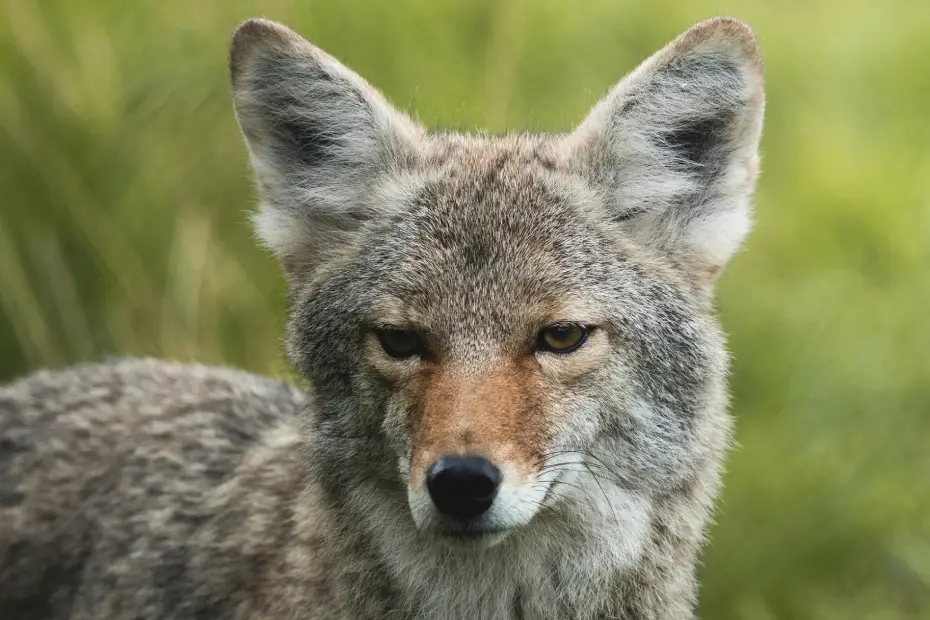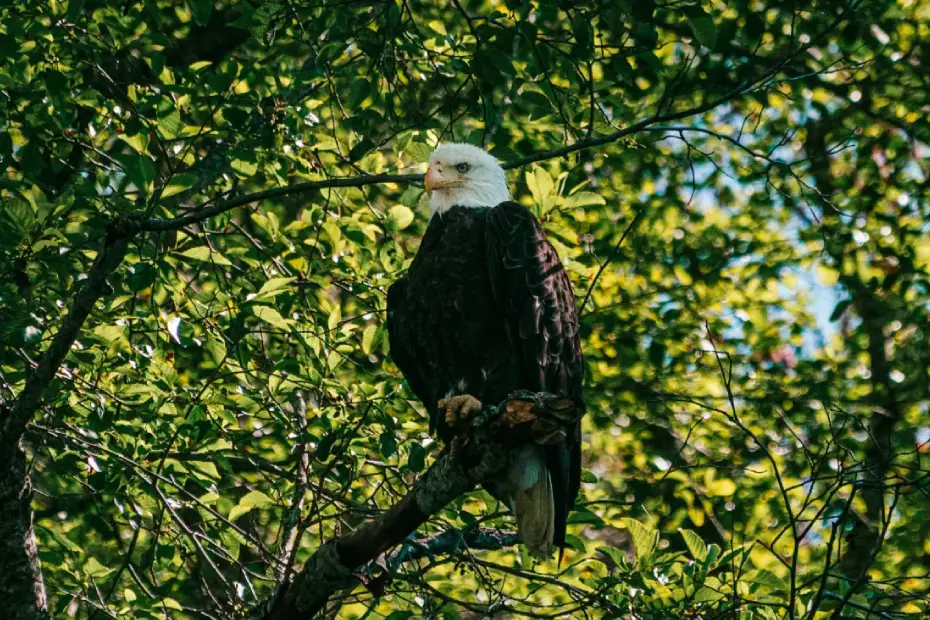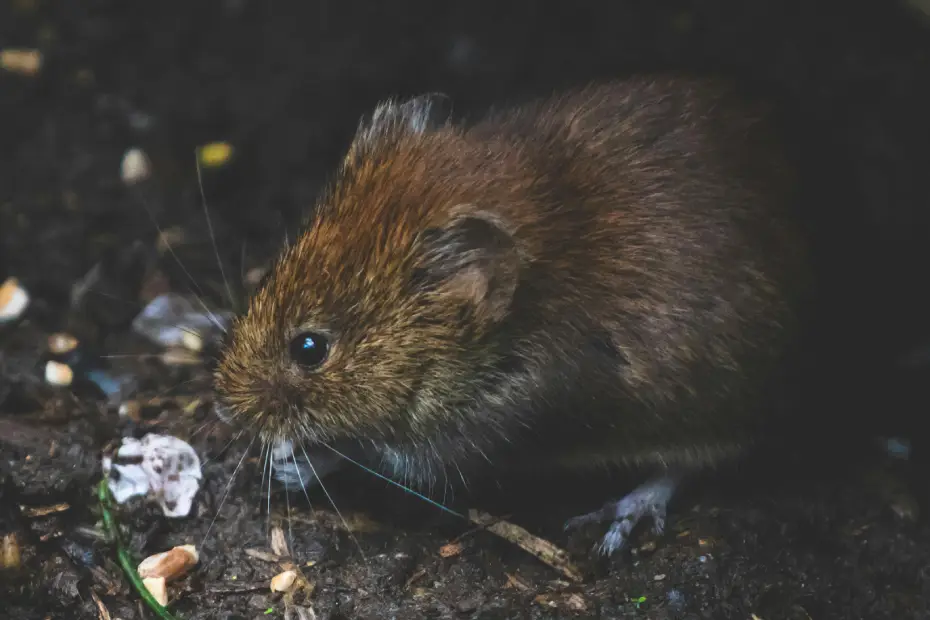Table of Contents
A cacophony of unsettling noises suddenly shatters the quiet of a suburban night. The area is filled with a melancholy wail and a string of high-pitched yells. The distinct call of coyotes is a sound that is at once fascinating and unsettling. These adaptable dogs, once restricted to isolated wilderness regions, are becoming more and more noticeable in suburban areas, where their nocturnal ballads are becoming a well-known, if occasionally unnerving, a feature of the ambient noise.
An in-depth discussion of coyote calls, their meanings, the causes of their nightly frequency, and strategies for peaceful coexistence with these wild neighbours in our growingly communal areas are covered in this blog post.
The Eerie Symphony of Coyote Calls
How do the calls of coyotes sound?
The vocalizations of coyotes are both varied and menacing. They can make a variety of sounds, like as barks, howls, yips, and yelps, all of which have different functions in their communication.
- Barks: Short, sharp sounds, often used as alarm signals or warnings.
- Howls: Long, mournful cries that can be heard from a distance, typically used for long-distance communication, territorial marking, or during mating season.
- Yips: High-pitched, excited sounds, often associated with playful interactions or greetings.
- Yelps: Short, sharp cries, often indicative of pain, distress, or submission.
When these cries are combined to create a sophisticated symphony, listeners may experience a variety of emotions. The sad howl that pierces the night has a raw beauty, but it can also chill you to the bone by serving as a reminder of the wildness that lingers in even the most well-manicured suburbs.
Why is the howl of coyotes at night?
Because coyotes are primarily nocturnal creatures, the frequency of their sounds during the night is explained by their increased activity. The whys of coyotes’ nighttime howling are multiple:
- Communication within the pack: Coyotes are gregarious creatures that inhabit groups. Their howling at night aids in communication, demarcation of territories, and coordination of hunting operations.
- Mating rituals: Coyotes utilize howling to draw potential mates and announce their availability during the breeding season.
- Social bonding: Group howling can strengthen the bonds within a pack and reinforce social hierarchy.
What is the range of coyote calls?
The range of coyote cries is astonishing. The eerie sound of a coyote howling may spread over great distances—up to several miles—in the right circumstances. The precise range may change according on variables including topography, the climate, and noise levels in the surrounding area. Calls can go further in open spaces than they do in congested or forested regions.
Interesting fact: An incredible 10 miles is the Guinness World Record for the farthest distance a coyote has been heard howling!
Their remarkable vocalization range shows the significance of coyotes for long-distance communication and territorial defense. It also emphasizes how difficult it can be to locate a howling coyote precisely because the sound sometimes seems to come from several different places.
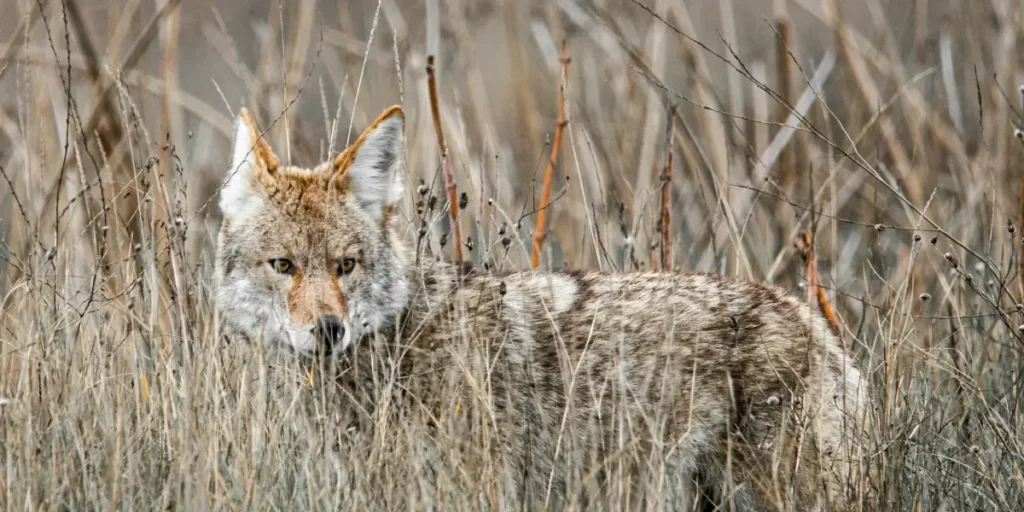
Decoding the Language of Coyotes
Through their calls, coyotes are trying to communicate what?
Coyote calls are a complicated language that reveal a great deal about the identity, goals, and emotional condition of the person making the call. Even if we are unable to fully understand the subtleties of their communication, we can learn some things by observing the various vocalizations and the circumstances surrounding them.
- Territorial marking: Howling is a common way for coyotes to alert other packs to their presence and to protect their territory.
- Locating pack members: Coyotes use howling to maintain communication with their pack members, particularly when they become separated when hunting or exploring.
- Coordinating hunting activities: During hunts, coyotes utilize vocalizations to coordinate their movements or to announce the location of prey.
- Attracting mates: Males utilize howls and other vocalizations to promote their fitness and attract females during the breeding season.
- Expressing excitement or distress: When coyotes feel threatened or are agitated, they may bark or yelp.
Other hints on the message being conveyed by the coyote can be found in the calls’ duration, intensity, and frequency. A sequence of brief, quick barks, for instance, could be an alert of impending danger, but a lengthy, drawn-out howl might signal a lone coyote looking for company.
Can anyone comprehend the communication of coyotes?
Even while we are unable to fully understand the complex language used by coyotes, we can learn to discern some of their body language and vocalizations. Coyote communication can be better understood by seeing them in their natural environment and listening to the meaning behind their calls.
Coyote communication can be better understood by using a number of materials, such as:
- Field guides: These manuals frequently provide explanations and analyses of the many coyote vocalizations.
- Online resources: Information about coyote behavior and communication may be found on a plethora of websites and videos.
- Wildlife experts: Seeking advice from nearby wildlife biologists or animal behaviorists can offer more profound understanding of coyote communication.
We can start to understand the intricacy and sophistication of coyote communication by fusing our keen observations with information from various sources.
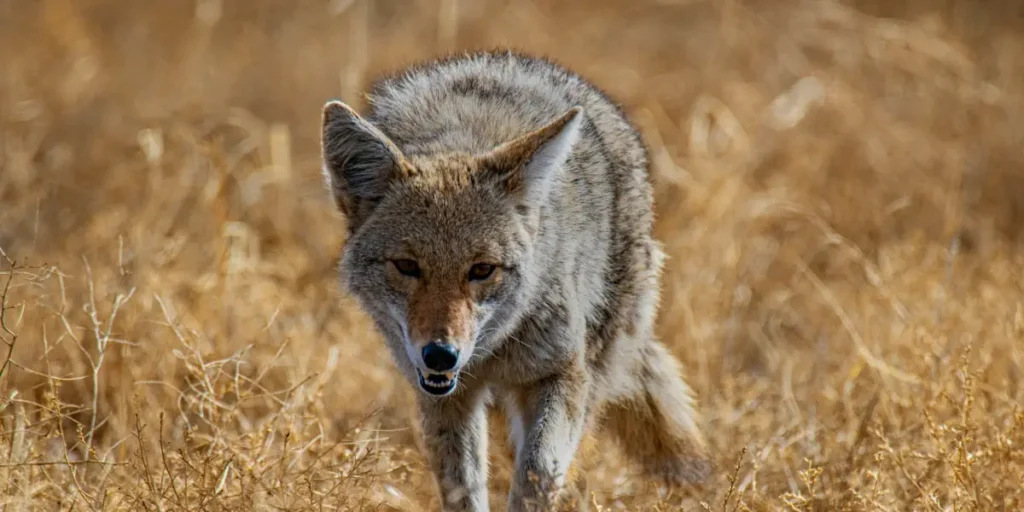
Encountering Coyotes in the Suburban Wilderness
Do coyotes pose a threat to people?
Concerns about coyotes’ possible threat to people have justifiably grown as their numbers in suburban areas have increased. Even though coyote attacks on people are uncommon, it’s still vital to be cautious and show respect for these wild creatures.
The majority of coyote assaults, according to the Humane Society of the United States, involve pets, especially small dogs and cats. Attacks on people are much rarer and usually involve coyotes that are either defending their young or have adapted to living with humans.
It is imperative to keep in mind that coyotes are untamed creatures and must not be approached or fed. We can live in harmony with these amazing animals by keeping a safe distance and taking precautions.
What should you do at night if you come across a coyote?
It can be shocking to come across a coyote at night, but it’s crucial to keep your cool and heed these safety advice:
- Make yourself appear large and loud: With a firm voice, raise your arms in the air and stand tall. This can help scare away the coyote by making it think you’re a threat.
- Maintain eye contact: Refrain from backing away or turning your back on the coyote as this may awaken its predatory tendencies.
- Back away slowly: Stay facing the coyote and gradually retreat to a safe distance.
- Carry a deterrent: A stick, noisemaker, or flashlight can all be useful tools for discouraging coyotes.
- Contact wildlife authorities: Even if you try to scare the coyote away, if it persists in its hostile behavior or comes near you, seek help from your local wildlife authorities.
What can you do to keep coyotes out of your backyard?
Preventive actions can greatly lower the chance of interactions with coyotes in your backyard:
- Secure garbage and compost bins: Store these in airtight containers or wildlife-resistant enclosures.
- Avoid leaving pet food outdoors: Feed your pets indoors or remove any leftover food promptly.
- Keep pets leashed and supervised: Don’t allow pets to roam freely, especially at night.
- Install motion-activated lights or sprinklers: Coyotes may be startled by these and deterred from coming into your yard.
- Fence your yard with coyote-proof barriers: To keep coyotes from digging under a fence, think about building one that is at least six feet tall and extends one foot below ground.
By following these tips, you can minimize the risk of coyote encounters and ensure the safety of both yourself and your pets.
Appreciating the Wild Neighbors
Coyotes’ ecological function in suburban habitats
Even though they are occasionally seen as a nuisance, coyotes are essential to preserving the natural equilibrium of suburban habitats. They aid in the management of mouse, rabbit, and other small animal populations that may harm gardens and other property since they are opportunistic feeders.
Coyotes also aid in halting the spread of disease among wildlife populations by feeding on sick or weak people. Because they keep fewer nest predators like opossums and raccoons around, their presence can even be beneficial to native bird species.
Coyotes are essentially a natural pest control method that also improves the general wellbeing and biodiversity of suburban habitats.
The mystique and splendor of the nighttime wildness
The eerie coyote calls that reverberate through the suburban night serve as a constant reminder of how wildness still exists in even the most developed of environments. They make us feel in awe of and connected to the natural world around us.
Listening to the nocturnal symphony of coyotes, owls, and other critters at night has a particular allure. It serves as a reminder that there are many different species on our world besides us, and that each one is essential to the complex web of life.
Keeping our planet healthy and vibrant requires protecting natural ecosystems and encouraging cohabitation with wildlife. We can build a more peaceful and sustainable future for everybody if we can learn to respect and comprehend coyotes and our other natural friends.
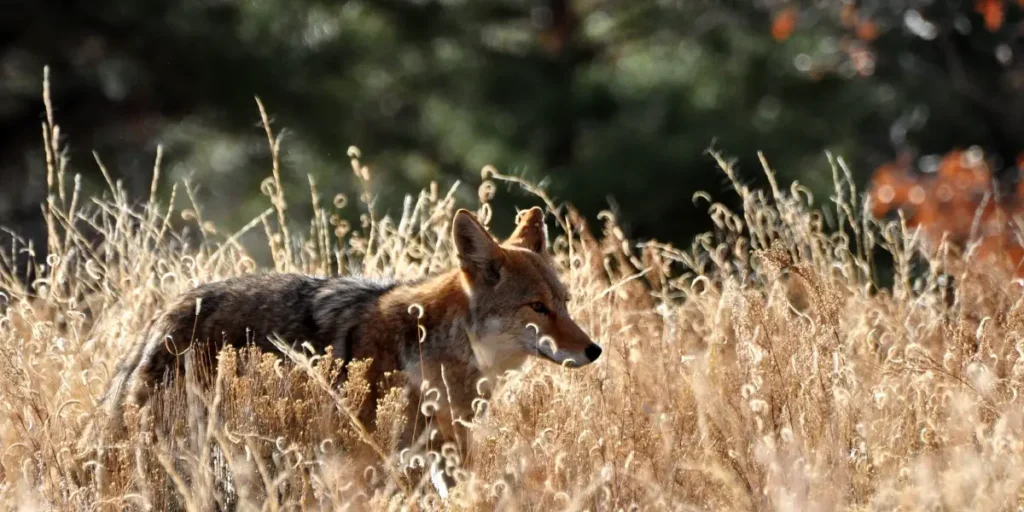
Conclusion
The encounter with coyote sounds at night in the suburban wilderness is evidence of these amazing animals’ adaptation and tenacity. Though occasionally unnerving, these haunting vocalizations provide an insight into their intricate social lives and ecological functions.
We can come to enjoy coyotes in our midst by learning the causes of their howling at night, deciphering their communication, and taking precautions to coexist harmoniously.
Recall that coyotes are essential to the balance and biodiversity of the suburban environment. Accepting the wildness that envelops us, let’s work toward living in harmony with these amazing animals.
Together, we can create a world where humans and coyotes can thrive side by side.
Additional Tips for Coexisting with Coyotes
- Never feed coyotes: Even inadvertent feeding might cause coyotes to become accustomed to humans and become more fearless. Coyotes may lose their innate fear of people and become more prone to approaching people or pets if they get used to eating from humans.
- Hazing: Hazing strategies are useful for scaring away coyotes who are approaching too closely. Creating loud noises, tossing objects in their direction without hitting them, and using a hose are some of these methods.
- Educate your community: Inform your neighbors about coyote behavior and coexistence techniques. A knowledgeable community is better able to avoid confrontations and encourage coyote cohabitation.
- Support wildlife conservation efforts: Coyotes benefit the overall ecosystem when natural habitats are preserved and organizations dedicated to maintaining animal populations are supported.
Interesting Facts about Coyotes
- Because of their great adaptability, coyotes can survive in a wide range of environments, including woods, deserts, and urban areas.
- Being omnivores, they consume carrion, fruits, insects, rodents, and rabbits.
- Coyotes are known for their intelligence and resourcefulness.
- They interact with one another by vocalizations, body language, and scent marking and have a sophisticated social structure.
- Through their ability to manage prey species populations, coyotes contribute significantly to the preservation of ecological equilibrium.
Resources for Further Learning
- The Humane Society of the United States: [invalid URL removed]
- Project Coyote: https://www.projectcoyote.org/
- The Urban Coyote Initiative: https://urbancoyoteinitiative.com/
Recall that the secret to living peacefully with coyotes is to respect their untamed nature and take proactive measures to avoid confrontations. We can guarantee a secure and peaceful coexistence with these amazing animals by being knowledgeable about their behavior and implementing the necessary safety measures.
Final Thoughts
Coyotes’ melancholic calls amid the suburban wilderness are a potent reminder of how intertwined all life is. We must develop peaceful coexistence with our wild neighbors as we continue to encroach on their natural habitats. We can guarantee a future in which coyotes and humans may coexist peacefully by respecting their limits, knowing their behavior, and recognizing their ecological purpose.
Additional Call to Action:
- To assist local wildlife organizations’ conservation efforts, think about volunteering or making a donation.
- By educating others about coyotes, you can help debunk myths and misconceptions surrounding these animals.
- Keep your pets under your supervision and on a leash as a responsible pet owner, especially in places where coyotes are known to be present.
Let’s work together to create a world where humans and wildlife can coexist in harmony.
